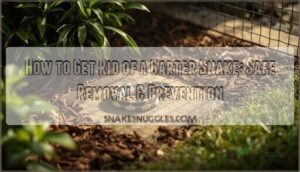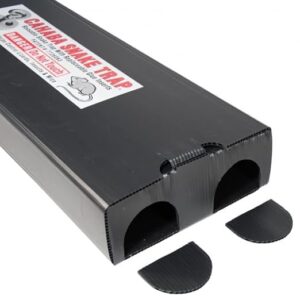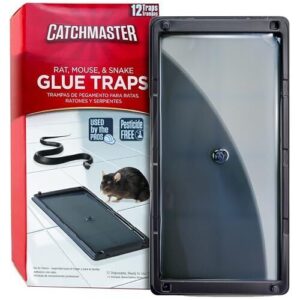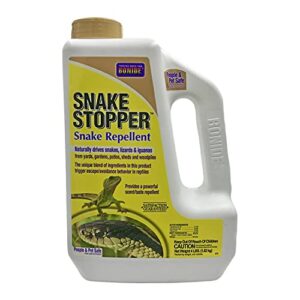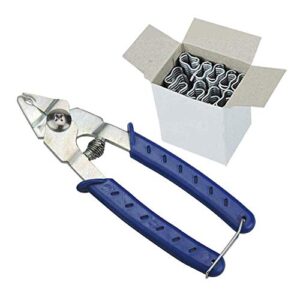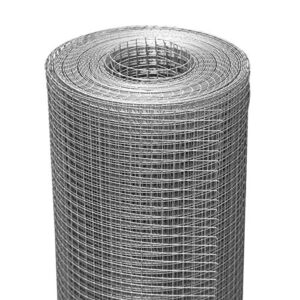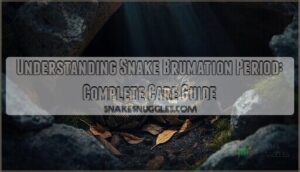This site is supported by our readers. We may earn a commission, at no cost to you, if you purchase through links.
That sleek striped snake sunning itself near your garden hose isn’t dangerous, but it’s got you second-guessing every step outside. Garter snakes won’t harm you—they’re nonvenomous and surprisingly beneficial—but when one takes up residence in your shed or slithers across your patio, peaceful coexistence loses its appeal fast.
The good news? You don’t need harsh chemicals or expensive exterminators to reclaim your space. A few strategic changes to your yard, some basic exclusion techniques, and the right removal approach will send these reptiles packing without putting anyone at risk.
Table Of Contents
- Key Takeaways
- Identifying Garter Snakes in Your Yard
- Why Garter Snakes Enter Homes and Gardens
- Step-by-Step Garter Snake Removal Methods
- Top 5 Products for Garter Snake Control
- Frequently Asked Questions (FAQs)
- How to get rid of garter snakes around the House?
- Can garter snakes be removed?
- Do garter snakes need to be killed?
- Can herbs prevent garter snakes?
- Do garter snakes come back?
- How do you catch garter snakes?
- What should I do if I am bitten by a garter snake?
- Is it okay to kill a garter snake that gets into my house?
- Can I use mothballs or sulfur to repel garter snakes?
- What plants or flowers will repel garter snakes from my yard?
- Conclusion
Key Takeaways
- Garter snakes won’t harm you since they’re nonvenomous, but you can get them off your property by sealing foundation cracks smaller than a quarter-inch, removing debris piles and woodstacks, and cutting off their food supply by controlling earthworms, slugs, and standing water.
- Physical barriers work better than repellents—install hardware cloth with quarter-inch openings buried at least three inches deep around your foundation, since studies show natural repellents like cinnamon oil and mothballs don’t actually keep snakes away.
- You can safely remove garter snakes yourself using snake hooks or towel capture methods while wearing thick gloves, but call wildlife removal pros if you’re dealing with multiple snakes, indoor invasions, or situations involving vulnerable family members.
- Garter snakes return to the same hibernation sites year after year due to strong den site fidelity, so short-distance relocation won’t work—you’ll need to move them several miles away or make your yard permanently unappealing through consistent habitat modification.
Identifying Garter Snakes in Your Yard
Before you can safely remove a garter snake, you need to know what you’re dealing with. These slender, striped reptiles have distinct features that set them apart from more dangerous species—and understanding those differences keeps you safe.
Let’s walk through the key traits, safety markers, and typical behaviors that’ll help you spot a garter snake in your yard.
Key Physical Characteristics
Garter snake identification starts with recognizing a few telltale signs. Most adults run between 18 and 51 inches long—think about two to four feet—with slender bodies covered in keeled scales that feel slightly rough to the touch.
Look for these snake body patterns:
- Three distinct stripes running head to tail in yellow, white, blue, or greenish tones
- Round eyes and pupils, paired with a relatively small, rounded head
- Color variations including black, brown, gray, or olive backgrounds, sometimes with red or orange spots between the stripes
These nonvenomous snakes show plenty of variety across their 35 species and subspecies. For accurate species classification, refer to the taxonomic classification guidelines.
Distinguishing Garter Snakes From Venomous Species
Knowing which snake you’re facing matters for safety. You’ll spot nonvenomous garter snakes by their round pupils, narrow oval heads barely wider than the neck, and those signature stripes. Venomous pit vipers show slit pupils, triangular heads much broader than the neck, and heat-sensing pits between eye and nostril.
Head morphology and pupil shape beat guesswork every time—copperheads sport hourglass bands, not continuous stripes, making snake identification straightforward once you know scale patterns. Understanding venomous snake characteristics is vital for safe removal.
Common Habitats and Behavior Patterns
Now that you’ve nailed the identification, watch where they actually hang out. Garter snake behavior revolves around habitat selection near moisture and prey-rich zones:
- Wetlands and grassy fields stay top choices—water sources pull them in
- Suburban yards with compost piles or firewood stacks offer perfect reptile biology refugia
- Morning and late afternoon mark peak activity windows
- Snake migration to winter dens happens each fall in colder climates
- Food chains tie them to gardens crawling with slugs and earthworms
Understanding animal behavior patterns helps you predict their next move.
Why Garter Snakes Enter Homes and Gardens
Garter snakes don’t wander into your yard by accident—they’re following a trail of what they need to survive. Your property might be offering the perfect combination of food, shelter, and water without you even realizing it.
Garter snakes aren’t lost—they’re following your yard’s hidden buffet of food, shelter, and water straight to your doorstep
Let’s break down the three main reasons these snakes decide to set up shop in your space.
Food Sources That Attract Garter Snakes
Think of your yard as an all-you-can-eat buffet for garter snakes. Earthworm control starts with reducing mulch and watering schedules—those wigglers are prime targets. Slug removal matters too; garter snakes love soft-bodied pests hiding in damp spots.
If you’ve got aquatic prey like tadpoles or small fish in ponds, you’re practically rolling out the welcome mat. Even small mammals around bird feeders can attract these hunters.
To eliminate food sources, you’ll need strategic pest control and smart snake habitat management.
Shelter and Hiding Spots
Garter snakes thrive in environments where warmth and cover intersect. Foundation gaps as narrow as six millimeters allow them easy access to the underbelly of homes. In yards, debris like woodpiles, leaf piles, and scattered boards create ideal habitats for these snakes. Additionally, rock piles near foundations serve as both sunning spots and shelter.
Below ground, subterranean dens and communal hibernacula house hundreds of snakes during winter. Effective snake habitat management and yard maintenance are crucial to eliminating these refuges before snake removal becomes necessary.
Water Features and Moist Environments
Beyond shelter, moisture draws garter snakes like a magnet. Water sources—ponds, birdbaths, leaky hoses—boost prey availability and create ideal hunting grounds. Studies show garter snakes prefer moist grasslands, where earthworm populations thrive.
Effective moisture control and yard drainage eliminate these attractions. By modifying snake habitat through strategic yard maintenance and wetland habitat reduction, you’ll make your property far less appealing, supporting long-term snake removal and wildlife control success.
Step-by-Step Garter Snake Removal Methods
Once you’ve figured out why garter snakes are hanging around your property, it’s time to take action. The good news is you don’t need harsh chemicals or drastic measures to get the job done.
Here’s a practical approach that combines prevention, habitat modification, and safe removal techniques to reclaim your space.
Sealing Entry Points and Gaps
Snakes don’t need much room—anything bigger than a quarter-inch is an open invitation. To seal cracks and gaps effectively, you’ll want to check every vulnerable spot and close it off with the right materials.
- Patch foundation cracks with mortar to eliminate underground entry routes
- Install door sweeps on all exterior doors, including garages
- Wrap pipes and wires with latex caulk or foam where they enter walls
- Cover vents and openings with hardware cloth or aluminum flashing in 0.5-inch mesh
- Schedule seasonal seal maintenance to catch new gaps before snakes do
Removing Food and Water Sources
You won’t get rid of garter snakes if their meal ticket stays in place. Prey reduction is your first move—control earthworms, slugs, and rodents through targeted pest control methods.
Next, tackle water management: drain standing water, cover ponds, and fix leaky spigots. Secure compost bins, clear debris piles, and reduce moisture around foundations to eliminate both food sources and the damp microhabitats snakes hunt in.
Modifying Landscaping and Yard Maintenance
Your lawn and garden design either rolls out the welcome mat for garter snakes or sends them packing. Keep grass mowed below three inches—research from Utah State shows short turf forces snakes into the open, where they feel exposed.
Remove debris piles, wood stacks, and dense ground covers near foundations. Install snakeproof fencing with openings under a quarter-inch, and replace organic mulch with gravel borders around buildings to disrupt their travel routes.
Safe Physical Removal Techniques
If you’d rather handle removal yourself, safety comes first. Wear thick gloves and long sleeves—garter snakes bite when cornered. Snake hooks between 24 and 40 inches let you guide the animal into a ventilated container without direct contact.
Towel capture works indoors: lay damp fabric, wait 48 hours, then bundle the snake into a bucket.
Manual handling? Grip mid-body firmly but gently to avoid injury—and expect musk.
When to Call Wildlife Removal Services
DIY removal works for one-time sightings, but multiple snakes in days, indoor activity, or failed exclusion mean it’s time for professional guidance. Emergency situations—bites, vulnerable family members, or snakes in living spaces—justify calling wildlife removal services immediately.
Typical removal costs run $200–$230 for garter snakes, with attic or crawl-space work pushing that higher. Licensed pros bring trained eyes, humane wildlife removal techniques, and pest control expertise that prevent costly repeat visits.
Top 5 Products for Garter Snake Control
The right tools can make garter snake control easier and more effective than relying on DIY methods alone.
From humane traps to physical barriers, these five products address different aspects of snake management—whether you’re dealing with an active infestation or working to prevent future visits.
Here’s what actually works based on real-world application and safety standards.
1. Reusable Snake Catch Trap System
A reusable snake catch trap system offers you a straightforward way to handle garter snakes without direct contact. These traps usually feature foldable designs for easy storage and strong corrugated plastic construction. Look for models with replaceable catch inserts—about 180 square inches of catch power—that can handle snakes up to 32 inches long.
Research shows modified traps boost catch rates by more than five times compared to standard versions. The best part? You’ll achieve effective reptile control while maintaining safety features that protect both you and the snake during removal.
Best For: Homeowners dealing with snake problems who want a hands-off solution for catching and relocating snakes without direct contact.
- Foldable design makes storage and transport super easy, and the corrugated plastic holds up well outdoors
- Modified trap designs can boost catch rates by over 5 times compared to basic versions, plus you get replaceable inserts for multiple uses
- Safe for everyone—lets you catch and release snakes without touching them, and it’s non-toxic around kids and pets
- Reviews are hit or miss on effectiveness, with some people reporting zero catches despite proper placement
- The plastic quality concerns some users—feels thin and flimsy, more like cardboard than durable outdoor material
- You’ll need to buy replacement catch inserts over time, which adds ongoing costs to what seems like a one-time purchase
2. Large Glue Mouse And Rat Traps
Glue traps—those red plastic boards you’ve seen for mice and rats—might seem like an easy fix, but their effectiveness for garter snakes is surprisingly limited. Open boards allow escapes nearly half the time, and you’ll need multiple traps edge-to-edge to catch a moving snake.
Even worse, non-target species like birds and pets can get stuck, creating serious welfare concerns.
If you do catch a snake, you can free it with vegetable oil applied outdoors, then relocate it safely away from your home.
Best For: People dealing with mice or rats who want a quick, non-toxic trap—but not recommended for targeting garter snakes due to low capture rates and welfare concerns.
- Ready to use right out of the package with no bait required, making setup quick and simple
- Safe for indoor use around your home and family without the toxicity risks of poison baits
- Works across different environments—homes, offices, warehouses, or barns—wherever rodents are a problem
- Poor effectiveness for snakes, with open boards allowing escapes in nearly half of encounters and requiring multiple traps placed edge-to-edge
- High risk of catching pets, birds, and other wildlife, leading to injury and requiring oil-based release procedures
- Creates animal welfare concerns due to prolonged distress, with trapped animals potentially suffering for extended periods before inspection
3. Natural Snake Repellent Granules
Natural snake repellent granules promise a hands-off solution with cinnamon, clove, and cedar oils as active ingredients. One popular bag covers 3,500 square feet and triggers escape behavior in reptiles.
But here’s the reality check: controlled studies on plains garter snakes showed naphthalene and sulfur blends didn’t create consistent avoidance. You’ll need to reapply every two weeks, especially after heavy rain washes away those essential oils.
While marketing claims sound convincing, habitat modification remains far more reliable than counting on granule effectiveness alone for keeping garter snakes at bay.
Best For: Homeowners looking for a pet-safe, chemical-free option to discourage snakes from yards and gardens, who don’t mind frequent reapplication.
- Natural ingredients like cinnamon, clove, and cedar oils make it safer around pets and kids compared to traditional chemical repellents
- Wide coverage area (up to 3,500 square feet per bag) lets you treat large perimeters without buying multiple products
- Pleasant scent is a huge upgrade from the harsh mothball smell of older naphthalene-based repellents
- Scientific studies show inconsistent results—garter snakes often ignore treated areas when food or shelter is available
- Requires reapplication every two weeks, and even more often after rain since the oils wash away quickly
- Less reliable than physical barriers or habitat changes like removing debris piles and sealing entry points
4. Hog Ring Pliers Tool Kit
For long-term snake removal and pest control, hog ring pliers secure hardware cloth to fence frames faster than hand-tying wire. You’ll close each ring in under two seconds—spacing them 12 inches apart along mesh seams creates barriers too tight for garter snakes to exploit.
The kit includes 600 galvanized rings that resist rust in wet soil where wildlife control matters most. Ring closure force stays consistent across hundreds of fence sealing applications, eliminating the irregular gaps that manual mesh installation often leaves behind.
Best For: DIYers and property owners installing snake-proof fencing or animal enclosures who need to secure hundreds of feet of wire mesh quickly without hand-tying every connection.
- Closes galvanized rings in under 2 seconds each, letting you fasten 200 feet of mesh in the time manual wire-tying would take for 50 feet
- Consistent ring closure eliminates the loose spots and irregular gaps that hand-twisted ties leave in snake barriers
- 600-ring kit covers typical backyard fence projects without reordering, and galvanized steel resists rust in wet soil for multiple seasons
- Quality control issues reported with plier springs and jaw fit, leading to frustration mid-project
- Difficult to operate for users with arthritis or limited hand strength, especially after fastening dozens of rings
- Some kits arrive with corroded rings or pliers that don’t grip properly, requiring returns or replacement parts
5. Hot Dip Galvanized Wire Mesh
Quarter-inch hardware cloth stops garter snakes when larger openings fail—the 6.35-millimeter aperture blocks even juveniles from slipping through. Bury three inches deep and angle the top 30 degrees outward to defeat climbers.
This 48-inch roll is hot-dip galvanized after welding, sealing weld points that corrode first in moist garden soil. In temperate zones, the zinc coating delivers decades of corrosion resistance without repainting.
Pair with hog ring pliers for fast mesh installation that eliminates the gaps snakes exploit around foundations and flowerbeds.
Best For: Homeowners who need reliable snake and rodent exclusion around gardens, porches, or foundations in areas with garter snakes or small pests.
- Quarter-inch openings effectively block even juvenile snakes and small rodents from entering protected areas
- Hot-dip galvanized after welding provides superior corrosion resistance at weld points, lasting decades in moist soil without rust
- 48-inch height covers the recommended 30 inches above ground while allowing burial depth to prevent burrowing underneath
- 23-gauge wire is thinner than premium options and may require doubling up for high-traffic areas or aggressive animals
- Cutting and shaping the thin wire can be challenging without sharp tin snips or specialized tools
- Higher per-foot cost compared to standard chicken wire or larger-mesh fencing that doesn’t offer the same level of protection
Frequently Asked Questions (FAQs)
How to get rid of garter snakes around the House?
You’ll need a three-part approach: seal cracks around your foundation with caulk or steel wool, eliminate shelter like woodpiles and dense vegetation, then install hardware cloth barriers buried at least twelve inches deep.
Can garter snakes be removed?
Yes, garter snakes can be removed using humane trapping techniques and safe physical capture. Wildlife control services handle relocations regularly, though moving snakes short distances yields better survival outcomes than long-distance transfers.
Do garter snakes need to be killed?
Absolutely not—killing garter snakes contradicts humane removal principles and overlooks their ecological benefits.
These creatures control pest populations naturally, pose minimal venom risk, and non-lethal methods provide effective snake removal without harming beneficial wildlife or violating conservation laws.
Can herbs prevent garter snakes?
Herb repellent efficacy remains unproven. Cinnamon and clove oils show brief retreat behavior in tests, but living snake repellent plants lack solid evidence.
Garter snake behavior adapts quickly, making essential oil barriers and natural repellent alternatives unreliable without habitat modification.
Do garter snakes come back?
Garter snakes exhibit strong den site fidelity, returning to the same hibernation sites and home range year after year.
Short-distance relocation strategies often fail—snakes navigate back unless moved several miles away permanently.
How do you catch garter snakes?
You can catch garter snakes using live traps placed along foundations, or with snake hooks and tongs for manual removal.
Humane capture methods and proper snake removal techniques guarantee safe garter snake control without injury.
What should I do if I am bitten by a garter snake?
Though garter snakes aren’t venomous snakes like rattlers, their bites still need first aid. Wash the wound immediately with soap and water, apply antiseptic, then bandage it.
Watch for infection risk and seek medical care if symptoms worsen.
Is it okay to kill a garter snake that gets into my house?
You wouldn’t tear up someone else’s road map, so don’t kill their guide home.
Most states protect garter snakes under wildlife laws, and humane removal beats legal trouble—plus, nonlethal snake control methods work better long-term anyway.
Can I use mothballs or sulfur to repel garter snakes?
No—mothball effectiveness and sulfur repellents are myths. Studies show these snake deterrents don’t work, plus outdoor use is illegal and dangerous.
Focus on habitat modification and repellent safety through proven snake prevention measures instead.
What plants or flowers will repel garter snakes from my yard?
Many homeowners plant marigolds, lemongrass, and garlic around garden borders, hoping aromatic herbs will act as snake deterrents. However, research shows these natural snake repellents offer little proven effect on garter snakes, despite widespread yard maintenance tips.
Conclusion
Think of garter snakes as uninvited houseguests—polite enough, but you still want them gone. Now you’ve got the playbook: seal the gaps, clear the clutter, and make your yard less of an all-you-can-eat buffet.
Knowing how to get rid of a garter snake means taking control without drama or danger. Apply these techniques consistently, and those slithering visitors will find somewhere else to call home. Your yard, your rules.
- https://cms.unl.edu/ianr/extension/wildlife/sites/unl.edu.ianr.extension.wildlife/files/media/file/garter-snakes-in-around-home.pdf
- https://www.dnr.state.mn.us/livingwith_wildlife/snakes/deterring.html
- https://icwdm.org/species/reptiles/snakes/snake-handling/
- https://extension.colostate.edu/resource/coping-with-snakes/
- https://www.thisoldhouse.com/pest-control/how-to-get-rid-of-snakes

